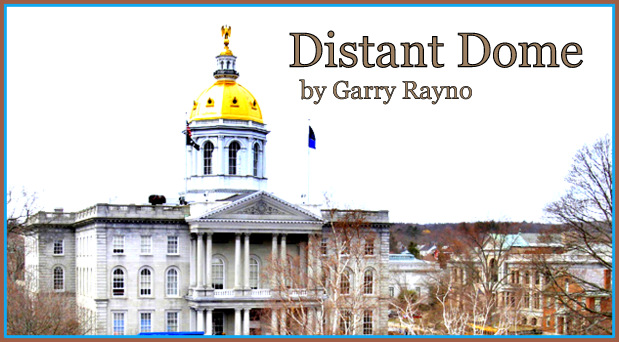By GARRY RAYNO, Distant Dome

Lawmakers and the general public this week will hear new Gov. Kelly Ayotte’s plan to craft the next biennial budget which is fraught with declining revenues, new obligations and more questions than answers about the federal funding the state depends on to survive.
Former Gov. Chris Sununu walked out of the State House in January and left his in-coming fellow Republican what is best described as a fiscal mess.
He asked his department heads to prepare budgets with 4 percent cuts, when others said, it should be 6 to 8 percent, and now talk is of an 11 to 14 percent reduction in the workforce.
While Sununu has been skiing at Waterville Valley, Ayotte and her budget team have been working overtime to fill the gap between expenditures and revenues that could approach $1 billion.
Thursday, the governor will present her budget address to lawmakers and that will put the budget season into overdrive at the State House and Legislative Office Building.
While the revenue decline is one hurdle to crafting a new biennial budget, there are others that are just as formable, such as the federal revenue stream and the work of the Department of Government Efficiency or DOGE taking a meat cleaver to what states and others once considered stable money sources.
Federal money pays about one-third of the expenses in the current biennial budget and provides more funding than the state’s general fund: $4.82 billion in federal funds compared to $4.27 billion in general funds according to figures from the New Hampshire Fiscal Policy Institute.
And the general fund figure may actually be less than that before the fiscal year ends June 30 if current revenues continue on their current trend.
While January revenues were a little more than budget writers’ estimates, the big concern has to be business tax revenue, the single biggest revenue source for the general and education trust funds.
Business taxes have been on the decline for about a year now, as the jet-propelled profits of national and multinational corporations was fueled by federal COVID relief and recovery money which has begun to wane, hurting New Hampshire’s revenue picture as well as most other states.
To date, the business tax revenues are 17.2 percent below a year ago, 18.2 percent below estimates of what is needed to balance the budget. That is almost 20 percent or the state is now taking in $4 for every $5 dollars of business taxes it collected last fiscal year.
The true tests will come in March and April when most of the businesses have to make their quarterly payments to the Department of Revenue Administration, and in June.
Those figures will be a bellwether for the next two years.
Some of the revenue problems have been the Legislature’s and governors’ own doing as they collectively approved rate reductions for both the Business Profits Tax and the Business Enterprise Tax for the last decade costing the state between $500 million and nearly $800 million since the reductions began, according to the NHFPI.
The business tax shortfall in January was offset by interest earned on the federal money which is being spent as deadlines approach, lottery earnings and the interest and dividends tax, which is no longer being assessed on earnings after Jan. 1.
None of the three categories of good news are stable revenue sources going forward that budget writers could count on for the next two fiscal years.
Everyone knows New Hampshire has an antiquated tax system heavily reliant on property taxes to pay for most local government and school district bills, it is also one of the most regressive tax systems in the country because it puts the largest tax burden percentage wise on those who can least afford to pay their taxes.
New Hampshire has also traditionally relied on what are called “sin taxes” as a way to grab money from out-of-staters when they visit, or the old adage “don’t tax me, tax the guy behind the tree.”
The taxes once included money from gambling at race tracks, which are no more, as well as liquor and tobacco sales, and sweepstakes tickets.
While the gambling money now comes to the state through charity gambling and the Lottery Commission, liquor and cigarette or tobacco sales are down and have been for a while as people stopped smoking and drinking as much and larger liquor chains are able to meet the state’s monopoly prices.
The Lottery Commission has seen its revenues increase for the Education Trust Fund from the larger and larger jackpots run up in several of the national lottery games that have helped put the fund in surplus which is now dwindling due to revenue shortfalls and the $50 million or so the Education Freedom Account program has drawn from the fund in new spending. It could be astronomically higher in the future if some lawmakers are successful in removing any salary cap from EFAs.
Real estate prices, more expensive mortgages and a small inventory have slowed home sales the last few years although the values have increased which has somewhat offset the drop in sales.
Revenues are not trending in the right direction and don’t appear to be making any corrections in the near future.
And President Donald Trump’s botched freeze on federal grants and loans sent shockwaves through state capitols and non profits who perform much of the work the federal money helps cover.
While he backed off, his actions certainly reminded state lawmakers the federal money could end with the chaos that now rules Washington.
Along with the uncertainty, budget writers face some daunting obligations like the $75 million pledged for the next 10 years to cover the cost of Youth Detention Center settlements for the physical, emotional and sexual abuse kids suffered at the hands of state employees at the Sununu Youth Services Center.
There are also two education funding lawsuits that reside with the Supreme Court and part of one remains in Superior Court.
The oral arguments have been made before the Supreme Court and everyone is waiting for the decisions, and the final section of the Rand suit has had its trial in Rockingham County Superior Court and waits for Judge David Ruoff to make his decision.
You could argue neither case would require more money be spent on public education, but instead both cases seek to shift what are now local costs recouped through local property taxes, to state revenue sources constitutionally raised, which the plaintiffs in both cases argued is not the current education funding scheme.
With Washington under Republican control, it is likely there will be some changes to the state-federal Medicaid health insurance program for the poor, those with disabilities or injuries, and mostly poor children and single-parent families.
Under several proposals floating in Washington, New Hampshire could have to pay an additional $500 million a year to cover the cost of the program, which also would likely end the Granite Advantage Plan, which insures the state’s working poor with the federal government paying 90 percent of the cost.
Traditionally when the state faces a budget crisis like it has today, one of the first places budget writers look for cuts are new programs.
Much of the new spending included in the current budget covers four areas: housing, child care, education and health care.
The most money for health care was a boost in Medicaid reimbursement rates to providers that has been a long time coming as the state had some of the lowest rates in the country. The new spending was $134.2 million, which could be a very visible target.
An additional $67 million was dedicated to children’s behavioral health, and home and community-based services for older adults and those with disabilities was boosted by more than 50 percent.
The current biennial budget included an additional $169 million for public education that increased the per-pupil grants and increased aid to communities with high poverty rates and low property values, but began phasing out the stability grants school districts have received since the last major change in the distribution formula more than 10 years ago.
The budget also contains a $50 million boost for state housing programs, and a significant boost in the child care scholarship program to make it easier for parents to afford child care in order to return to the workforce.
Those seeking to make the EFA program universal or open to all the state’s children regardless of how wealthy their parents are, like to say it’s all about the kids.
The childcare scholarship program and housing grants are also all about the kids, so if the EFA advocates do not vote to retain those programs, then EFAs are not really about the kids, but about politics instead.
Thursday the governor will tell us what her choices are for the next two years.
Garry Rayno may be reached at garry.rayno@yahoo.com.
Distant Dome by veteran journalist Garry Rayno explores a broader perspective on the State House and state happenings for InDepthNH.org. Over his three-decade career, Rayno covered the NH State House for the New Hampshire Union Leader and Foster’s Daily Democrat. During his career, his coverage spanned the news spectrum, from local planning, school and select boards, to national issues such as electric industry deregulation and Presidential primaries. Rayno lives with his wife Carolyn in New London.





